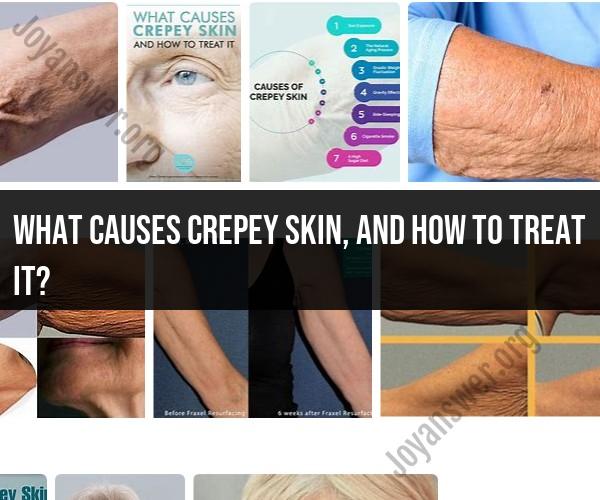What causes Crepey skin, and how to treat it?
Crepey skin is characterized by thin, fragile, and loose skin that resembles crepe paper. It is often associated with aging, but several factors can contribute to its development. Here's a comprehensive guide on the causes of crepey skin and how to treat it:
Causes of Crepey Skin:
Aging: The natural aging process is the most common cause of crepey skin. As we age, our skin produces less collagen and elastin, which are essential proteins that maintain skin's firmness and elasticity.
Sun Exposure: Chronic sun exposure, especially without proper sun protection, can accelerate the breakdown of collagen and elastin in the skin. UV rays can lead to premature aging and the development of crepey skin.
Dehydration: Inadequate hydration can lead to skin dryness and reduced skin elasticity. Drinking enough water and using moisturizers can help prevent crepey skin due to dehydration.
Smoking: Smoking can damage collagen and elastin fibers, leading to skin aging and the development of crepey skin.
Weight Loss: Rapid or significant weight loss can result in loose skin, including crepey skin, as the skin loses its elasticity and struggles to adapt to the reduced volume.
Poor Nutrition: A diet lacking in essential nutrients, such as vitamins, minerals, and antioxidants, can contribute to skin aging and crepey skin. Consuming a balanced diet can help support skin health.
Treatment Options for Crepey Skin:
Topical Treatments:
- Moisturizers: Using hydrating creams and lotions can improve skin hydration and temporarily reduce the appearance of crepey skin.
- Retinoids: Prescription retinoids or over-the-counter retinol products can help stimulate collagen production and improve skin texture.
- Hydroxy Acids: Alpha hydroxy acids (AHAs) and beta hydroxy acids (BHAs) can help exfoliate the skin and improve its appearance.
Medical Procedures:
- Chemical Peels: Chemical peels performed by dermatologists can remove the top layer of the skin, promoting collagen production and improving skin texture.
- Microneedling: This procedure involves using tiny needles to create controlled skin injuries, which stimulates collagen production and helps improve skin tightness.
- Lasers and Radiofrequency: Various laser and radiofrequency treatments can stimulate collagen and elastin production, promoting skin tightening.
- Dermal Fillers: Injectable fillers can be used to plump and tighten the skin, reducing the appearance of crepey skin in certain areas.
- Ultherapy: Ultherapy is a non-invasive procedure that uses focused ultrasound energy to lift and tighten loose skin.
Lifestyle Changes:
- Sun Protection: Always use sunscreen with an SPF of at least 30, wear protective clothing, and avoid excessive sun exposure.
- Healthy Diet: Consume a diet rich in fruits, vegetables, and foods high in antioxidants to support skin health.
- Hydration: Drink plenty of water to maintain skin moisture.
- Smoking Cessation: Quitting smoking can prevent further damage to the skin.
Cosmetic Products:
- Makeup: High-quality makeup products can help camouflage the appearance of crepey skin, providing a smoother texture.
It's important to note that results from treatment can vary depending on the severity of crepey skin, individual factors, and the chosen treatment method. Consult with a dermatologist to discuss your specific concerns and develop a personalized treatment plan for addressing crepey skin. Additionally, prevention and maintaining a healthy lifestyle can be essential in slowing the development of crepey skin.
What causes Crepey skin, and how can it be treated?
Crepey skin is a condition that causes the skin to become thin, fragile, and wrinkled. It is most common on the arms, thighs, and neck, but it can also occur on the face. Crepey skin is caused by a number of factors, including:
- Age: As we age, our skin naturally produces less collagen and elastin, the proteins that give skin its structure and elasticity. This can lead to crepey skin.
- Sun exposure: Sun damage can also break down collagen and elastin, contributing to crepey skin.
- Smoking: Smoking damages blood vessels, which can reduce blood flow to the skin and deprive it of nutrients. This can lead to premature aging and crepey skin.
- Weight loss: Rapid weight loss can cause the skin to stretch too quickly, leading to crepey skin.
- Certain medical conditions: Certain medical conditions, such as eczema and psoriasis, can also make the skin more susceptible to crepey skin.
There is no cure for crepey skin, but there are a number of treatments that can help to improve its appearance. These treatments include:
- Moisturizers: Moisturizing the skin regularly can help to plump it up and reduce the appearance of crepey skin. Look for moisturizers that contain ingredients such as hyaluronic acid, glycerin, and ceramides.
- Retinoids: Retinoids are topical creams or gels that can help to stimulate collagen production and improve skin texture.
- Alpha hydroxy acids (AHAs): AHAs are chemical exfoliants that can help to remove dead skin cells and reveal smoother, younger-looking skin.
- Lasers and other energy-based devices: Lasers and other energy-based devices can be used to heat the skin and stimulate collagen production. This can help to improve the appearance of crepey skin.
Are there lifestyle changes that can help improve Crepey skin?
Yes, there are a number of lifestyle changes that can help to improve crepey skin. These changes include:
- Protecting your skin from the sun: Sun exposure is one of the leading causes of crepey skin. It is important to protect your skin from the sun by wearing sunscreen, protective clothing, and a hat when you are outdoors.
- Quitting smoking: Smoking damages blood vessels and deprives the skin of nutrients. Quitting smoking can help to improve the appearance of crepey skin.
- Maintaining a healthy weight: Rapid weight loss can cause the skin to stretch too quickly, leading to crepey skin. Maintaining a healthy weight can help to prevent crepey skin.
- Eating a healthy diet: Eating a healthy diet can help to improve overall skin health. Make sure to eat plenty of fruits, vegetables, and whole grains.
What skincare products or regimens are effective for Crepey skin?
A good skincare regimen for crepey skin should focus on moisturizing, exfoliating, and stimulating collagen production. Here is an example of a skincare routine for crepey skin:
- Morning:
- Cleanse your skin with a gentle cleanser.
- Apply a moisturizer with SPF 30 or higher to protect your skin from the sun.
- Evening:
- Cleanse your skin with a gentle cleanser.
- Apply a moisturizer containing retinoids or AHAs.
You may also want to consider using a serum containing hyaluronic acid or other hydrating ingredients.
Can you recommend professional treatments for Crepey skin?
There are a number of professional treatments that can be used to improve the appearance of crepey skin. These treatments include:
- Lasers: Lasers can be used to heat the skin and stimulate collagen production. This can help to improve the appearance of crepey skin.
- Microneedling: Microneedling is a procedure that uses tiny needles to create microscopic punctures in the skin. This stimulates collagen production and can help to improve the appearance of crepey skin.
- Radiofrequency (RF) therapy: RF therapy uses radio waves to heat the skin and stimulate collagen production. This can help to improve the appearance of crepey skin.
- Fillers: Fillers can be used to plump up the skin and reduce the appearance of wrinkles.
How can one prevent Crepey skin from worsening?
The best way to prevent crepey skin from worsening is to take steps to protect your skin from the sun and avoid smoking. You should also maintain a healthy weight and eat a healthy diet.
Here are some additional tips for preventing crepey skin:
- Avoid taking long, hot showers or baths.
- Use a humidifier in your home to add moisture to the air, especially in the winter.
- Exfoliate your skin regularly to remove dead skin cells.
- Apply a moisturizer immediately after bathing or showering.



